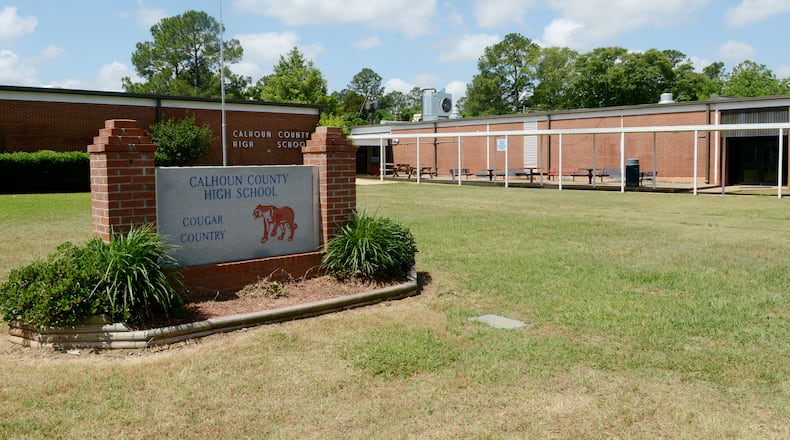Gov. Nathan Deal and lawmakers were unhappy last year when only 40 percent of Georgia school districts gave teachers the salary hikes the General Assembly promised.
This year most gave at least the 2 percent increase approved by lawmakers, according to a state Department of Education survey obtained by The Atlanta Journal-Constitution. But the survey found something else: Eight years after the Great Recession ended, a few rural school districts still have to furlough staffers to keep their doors open.
That surprised House Appropriations Chairman Terry England, R-Auburn, who has sought to get financial help to rural districts in the past.
“Part of it is that their property tax revenues have not caught up with pre-recession levels,” England said. “There is very little happening in any of those (communities) that will turn that around.”
The desperate plight of small-town hospitals has been well documented in recent years, but rural school districts have long faced some of the same challenges: a shrinking or stagnant population and small commercial base, which in turn means property tax revenue to supplement state funding is hard to come by.
On top of that, state budgets have included, for more than a decade, “austerity cuts,” reductions in what the funding formula says districts are supposed to receive to educate children. Deal and lawmakers have whittled down what had been an annual cut of about $1 billion to $166 million in recent years.
But those “austerity cuts,” which grew during the Great Recession, are one of the reasons many districts say they diverted teacher raise money in the past for other things, such as reducing furloughs or adding back instruction days to shortened school years.
Politically, lawmakers want to be able to brag about giving teachers raises, particularly when they put hundreds of millions of dollars into the budget for that purpose. Besides cost-of-living raises funded by the state, many educators also get longevity increases for teaching another year.
Until this year, Deal and legislators had given local school boards the flexibility to decide how to spend the money for cost-of-living raises. Many chose to use it to get them back to where they were before the recession or for one-time bonuses to teachers that wouldn't obligate them to pay the same amount the next year.
This year, Deal and lawmakers all but mandated 2 percent pay raises, and the Education Department survey showed only three districts and a handful of state charter schools didn’t give any pay hikes. A few others gave teachers one-time bonuses, such as Cobb County, where the school board approved 1.1 percent awards.
Deal expected every district to comply with the General Assembly’s wishes.
“It’s disappointing to see certain school systems did not pass on raises clearly intended for pay raises,” said his spokeswoman, Jen Ryan.
One of the districts listed as giving no raises was the Chattooga County School District.
However, Chattooga Superintendent Jimmy Lenderman said the survey was wrong, and his teachers got the state raise.
Two others on the list, Calhoun County Schools in southwest Georgia and Dublin City Schools, are both facing financial issues. Dublin officials have been trying to whittle away at a sizable deficit. Calhoun officials said in the survey that they saw a $234,000 cut this year in state funding meant to aid districts with low property wealth.
Calhoun was also one of the district that reported having furloughs — seven days' worth this school year. Attempts to reach officials in the district were unsuccessful.
Furloughs of teachers and school staff were common from 2009 to 2012 as the state tried to dig its way out of the Great Recession. The downturn brought a major decline in state tax revenue, and lawmakers cut school funding to balance the budget.
The Education Department report said 11 school districts had furloughs in fiscal 2017, which ended June 30. Five districts planned furloughs this year, although one has since decided against them.
The Meriwether County School System, southwest of Atlanta, reported that its staffers will take five furlough days without pay this year.
Tim Dixon, the district’s superintendent of schools, said the system has been working to get out of debt. When he arrived two years ago, district staffers had to take off 10 days a year without pay. By next year he’s hoping the furloughs will be eliminated.
“We are like many other small districts,” Dixon said. “We are losing what little industry we have and our enrollment continues to decline.”
Despite that, Dixon said the local school board “felt compelled” to give teachers raises.
“Like teachers in other districts, our folks work hard and we did not feel like five furloughs on top of no pay raise was fair to our folks,” he said. “I have never been a fan of balancing the budget on the backs of our teachers and staff. “
England, the lawmaker, said the Education Department survey showed most districts got the message members of the General Assembly intended to send: Pay raise money should go for pay raises.
Angela Palm of the Georgia School Boards Associations touted it as a sign that most districts have stabilized financially enough to give raises.
But she added: “For all the reasons you see in other reports, many rural districts are struggling financially because their community is struggling. Hopefully the focus being put on rural issues will help us find new or better ways to address these problems.”
The House and Senate both have committees traveling across the state studying the problems of rural Georgia, and they expect to make recommendations before the General Assembly reconvenes in January.
John Palmer, a Cobb County educator and spokesman for the teacher group TRAGIC, said the financial “shell games” of state leaders — touting pay raises while maintaining “austerity cuts” — hasn’t helped the situation.
“Those districts who have been able to absorb the cuts locally are keeping their heads above water, but districts without a strong commercial tax base are still struggling to keep their doors open,” Palmer said. “The austerity cuts and continual shifting of costs to local districts are creating a two-tiered system of education in Georgia.
“All of Georgia’s students deserve a quality education, not just the ones who live in districts who can raise their own local taxes to cover the lack of state funding for schools.”
About the Author
Keep Reading
The Latest
Featured



